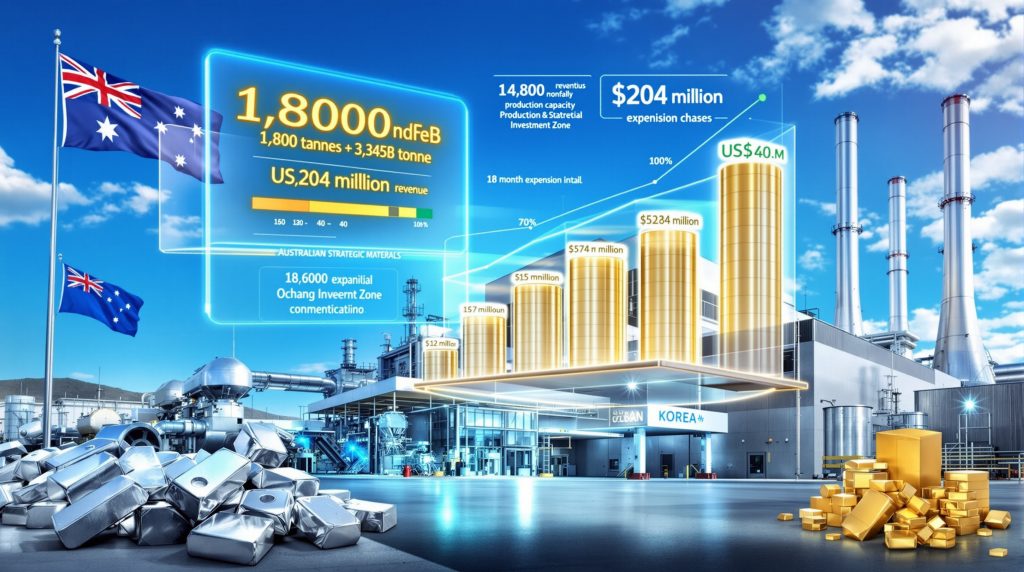Strategic Positioning in Critical Minerals Markets
Australian Strategic Materials has carved out a distinctive position within the global rare earth sector through its comprehensive mine-to-metals approach, establishing operations that span from resource extraction to final product manufacturing. This vertical integration strategy enables the company to maintain quality control throughout the entire production chain while reducing dependence on external processors, particularly as the critical minerals energy transition reshapes global supply chains.
The company's Korean operations represent a cornerstone of its strategy to serve Western markets with non-Chinese sourced materials. Located in the Ochang Foreign Investment Zone, the facility has demonstrated consistent production capabilities since commissioning in 2022, building a track record that distinguishes it from emerging competitors in the space.
Unlike traditional mining companies that focus solely on raw material extraction, ASM has developed metallurgical expertise that allows it to produce finished neodymium-iron-boron alloys. This capability positions the company to capture significantly higher margins compared to concentrate producers while providing customers with a reliable alternative to Chinese-dominated supply chains.
Capital Raise Strengthens Expansion Foundation
The October 2025 institutional placement demonstrates robust investor confidence in ASM's growth trajectory, with the $55 million raised at $1.20 per share attracting participation from both Australian and international investors. The placement included significant support from US-based institutional funds, reflecting growing international recognition of the company's strategic value proposition.
Managing director Rowena Smith emphasized that the successful capital raise provides full funding to complete the next phase of growth activities. The participation of new institutional investors alongside existing shareholders indicates broadening market awareness of ASM's unique position in the critical minerals sector.
Following completion of the placement, ASM expects to hold approximately $84 million in cash, providing substantial financial flexibility for ongoing project development activities. This strengthened balance sheet enables the company to pursue expansion opportunities while maintaining capacity to service existing debt obligations related to its Korean operations.
The timing of the capital raise coincides with heightened global focus on supply chain security, particularly as governments and industries seek alternatives to traditional sourcing arrangements. This geopolitical backdrop has created favorable conditions for companies offering diversified supply options outside established export-dependent regions.
Current Production Infrastructure and Capabilities
The Korean Metals Plant currently operates with an established production capacity, serving customers across Europe, Korea, and the United States. Since commissioning in 2022, the facility has built a proven track record of consistent alloy production, meeting Western industrial quality standards required by international magnet manufacturers.
The facility specialises in producing neodymium-iron-boron alloys, essential components for permanent magnets used in electric vehicles, wind turbines, and defence applications. These high-performance materials require precise metallurgical processes and quality control measures that ASM has successfully implemented through its Korean operations.
Current customer relationships span multiple geographic regions, providing revenue diversification while reducing dependence on any single market. The company has established long-term supply agreements with magnet manufacturers, creating predictable revenue streams that support expansion planning and investment decisions.
Quality certifications and production standards at the Korean facility meet requirements for Western industrial applications, differentiating ASM's products from lower-grade alternatives. This focus on quality positioning enables the company to command premium pricing while building customer loyalty in strategic markets.
Doubling Production Through Phase 2 Expansion
The Phase 2 expansion program represents a transformational growth opportunity, targeting production capacity increases to 3,600 tonnes of NdFeB alloy annually. This doubling of output capacity requires approximately US$8 million in capital expenditure over an 18-month implementation timeline.
Upon completion, the expanded facility is projected to generate annual revenues of approximately US$204 million with EBITDA of around US$26 million. These financial projections are supported by existing long-term supply agreements with magnet manufacturers, providing visibility for revenue realisation from increased production capacity.
The expansion timeline reflects careful planning to minimise operational disruption while maximising production efficiency improvements. Equipment installation and commissioning activities are structured to maintain current production levels during the transition period, ensuring continuity of customer supply arrangements.
Beyond Phase 2, ASM is evaluating potential for Phase 3 expansion to 5,600 tonnes annually, demonstrating the scalability of its Korean operations. This long-term planning approach positions the company to respond to growing demand while maintaining operational flexibility as market conditions evolve.
Product Portfolio Driving Revenue Growth
Neodymium-iron-boron alloys represent the primary revenue driver for ASM's Korean operations, with these materials serving as critical inputs for high-performance permanent magnet production. The alloys produced meet specifications required for automotive, renewable energy, and defence applications where magnetic performance is essential.
Supply agreements with international magnet manufacturers provide predictable demand for ASM's Korean production, enabling capacity planning and investment decision-making. These relationships have developed through demonstrated product quality and reliable delivery performance over the facility's operational history.
The company's focus on Western market requirements has enabled it to develop product specifications that meet stringent quality standards while commanding premium pricing. This differentiation strategy contrasts with commodity-focused approaches that compete primarily on cost rather than performance characteristics.
Quality control processes implemented at the Korean facility ensure consistent product performance across production batches, building customer confidence and supporting long-term supply relationships. These operational capabilities represent competitive advantages that are difficult for new entrants to replicate quickly.
Geopolitical Factors Influencing Strategic Direction
Current geopolitical tensions have created unprecedented focus on critical minerals supply chain security, particularly as export restrictions and trade policies affect traditional sourcing arrangements. Furthermore, the US–China trade war impact has intensified these conditions, increasing urgency among governments and industries seeking alternative supply sources.
Rowena Smith noted that the Korean facility represents an established, stable producer during a period of unpredictable and volatile global conditions. This stability becomes increasingly valuable as customers prioritise supply security alongside cost and quality considerations in their sourcing decisions.
Government priorities for supply chain diversification have created supportive policy environments for non-Chinese rare earth producers, including favourable regulatory treatment and potential financial incentives. Consequently, Trump's critical minerals order has enhanced the strategic value of ASM's Korean operations while supporting expansion planning.
Export restrictions affecting traditional suppliers have disrupted established trading patterns, creating opportunities for alternative producers to capture market share. ASM's operational readiness positions it to respond quickly to these market opportunities as they develop.
Regional Hub Strategy for Global Operations
Korea's role in ASM's global expansion strategy extends beyond production capacity to include technology transfer and operational expertise development. The Korean facility serves as a testing ground for processes and procedures that will inform future expansion projects, particularly the proposed American Metals Plant.
Metallurgical knowledge gained through Korean operations provides the foundation for replicating successful production processes in other jurisdictions. This technology transfer capability reduces development risks while accelerating deployment timelines for new facilities.
The Korean facility's geographic position within Asian manufacturing networks provides logistical advantages for serving regional customers while maintaining access to international markets. This dual capability enhances operational flexibility and market responsiveness.
Skilled workforce development at the Korean facility creates a knowledge base that can support training and technical assistance for future operations. This human capital development represents a strategic asset that differentiates ASM from competitors lacking operational experience.
American Market Entry Strategy
The proposed American Metals Plant represents a natural extension of ASM's Korean success, leveraging proven technologies and processes for US market entry. Initial capacity planning targets 2,000 tonnes annually with potential employment for up to 150 skilled workers.
The American facility would establish a non-Chinese feedstock pathway for US-based magnet manufacturers, addressing strategic priorities for domestic supply chain development. This positioning aligns with government policies promoting critical minerals security while serving growing industrial demand.
ASM is currently evaluating several state-based incentive packages for the proposed American facility, reflecting competitive interest from regional governments seeking advanced manufacturing investments. These incentive programs could significantly improve project economics while accelerating development timelines.
The proposed American facility represents ASM's strategy to replicate Korean success while serving domestic US demand for non-Chinese rare earth sources.
Korean operational expertise will inform American facility development, reducing technical risks while optimising production processes from project inception. This knowledge transfer capability provides competitive advantages over competitors developing facilities without proven operational experience.
Strategic Partnership Network
ASM has established a growing network of strategic partnerships that support its Korean expansion while providing foundation for broader growth initiatives. The five-year sales and tolling framework with USA Rare Earth creates predictable demand channels for increased production capacity.
The memorandum of understanding with Neo Performance Materials focuses on heavy rare earth sales expansion, diversifying ASM's product portfolio while accessing additional market channels. These partnerships provide revenue visibility that supports expansion investment decisions.
Long-term supply agreements with international magnet manufacturers create stable demand foundations for Korean facility expansion. These relationships have developed through consistent product quality and reliable delivery performance, building customer confidence in ASM's capabilities.
Partnership development strategies focus on Western market participants seeking alternatives to traditional sourcing arrangements. This alignment with customer strategic priorities creates mutually beneficial relationships that support long-term growth planning.
Integration with Dubbo Project Development
The Dubbo project in New South Wales provides the resource foundation for ASM's mine-to-metals strategy, connecting Australian mineral resources with Korean processing capabilities. This integration creates a vertically integrated supply chain that reduces external dependencies while capturing value across multiple stages of production.
Over $1.5 billion in conditional debt funding has been secured from Export Finance Australia, the US Export-Import Bank, and Export Development Canada, positioning Dubbo as one of the most advanced rare earth developments outside China. This financial support reflects institutional confidence in the project's strategic importance.
Resource-to-processing integration enables ASM to optimise product specifications for end-market requirements while maintaining cost competitiveness. This vertical integration capability differentiates the company from competitors focused on single stages of the value chain.
Logistical planning for connecting Dubbo resources with Korean processing capabilities includes shipping route optimisation and inventory management strategies. These operational considerations ensure efficient material flows while minimising transportation costs and supply disruption risks.
Financial Strength Supporting Multi-Jurisdictional Growth
ASM's strengthened financial position provides flexibility for pursuing growth opportunities across multiple jurisdictions while maintaining operational stability. The $84 million expected cash position following placement completion creates substantial capacity for expansion activities.
In addition to strengthening their balance sheet, companies in the critical minerals sector are increasingly focusing on capital raising strategies that align with investor expectations for sustainable growth. Debt management capabilities enable the company to service existing Korean facility obligations while maintaining capacity for additional project financing.
Capital allocation priorities balance immediate expansion opportunities with longer-term strategic investments, ensuring optimal resource utilisation across the company's development portfolio. This disciplined approach maximises shareholder value while maintaining growth momentum.
International debt facility arrangements provide additional financing flexibility for projects spanning multiple countries and currencies. These capabilities reduce financing constraints while enabling responsive capital deployment as opportunities develop.
Market Conditions Supporting Strategic Investments
Growing demand for electric vehicle components creates sustained market expansion for rare earth magnets, directly benefiting ASM's Korean production capabilities. Industry forecasts indicate continued growth in EV adoption rates, supporting long-term demand projections for neodymium-iron-boron alloys.
Wind turbine industry expansion drives additional demand for high-performance permanent magnets, creating multiple end-market drivers for ASM's products. Renewable energy deployment policies in Western markets support sustained demand growth beyond traditional applications.
Defence applications requiring high-performance magnets represent strategic market segments where supply security considerations outweigh cost optimisation. These applications provide premium pricing opportunities while supporting diversified revenue streams.
Industrial automation and robotics applications create emerging demand categories for precision magnetic components, expanding addressable market opportunities beyond traditional sectors. These developing applications support long-term growth prospects while reducing dependence on established market segments.
What Makes ASM's Korean Operations Unique?
ASM's Korean facility provides established production credentials that differentiate the company from development-stage competitors lacking operational experience. This track record creates customer confidence while supporting expansion financing and partnership development activities.
Quality certifications meeting Western industrial standards enable premium pricing while building customer loyalty in strategic market segments. These quality advantages create competitive moats that protect market position as competition intensifies.
Geographic positioning within Asian manufacturing networks provides logistical advantages while maintaining access to Western markets. This dual capability enables responsive customer service while optimising distribution costs across diverse market segments.
How Does Operational Flexibility Create Competitive Advantages?
Operational flexibility developed through Korean facility management creates capabilities for rapid response to changing market conditions. This adaptability provides competitive advantages in dynamic market environments where customer requirements evolve quickly.
Moreover, European CRM facility insights demonstrate the importance of operational adaptability in meeting diverse regulatory and market requirements across different jurisdictions.
Long-Term Growth Trajectory and Expansion Options
Phase 3 evaluation for 5,600 tonnes annual capacity demonstrates the scalability potential of ASM's Korean operations beyond immediate expansion targets. This long-term planning approach provides flexibility for responding to market growth while maintaining operational efficiency.
Additional Korean facility development represents potential expansion options as demand growth justifies increased regional capacity. These strategic options provide growth levers that can be activated based on market conditions and customer requirements.
Integration with broader Asia-Pacific supply chain strategies creates opportunities for regional hub development serving multiple market segments. This strategic positioning enhances long-term growth prospects while optimising operational synergies across facilities.
Technology development and process optimisation activities at the Korean facility support continuous improvement initiatives that enhance competitiveness. These capabilities create sustainable competitive advantages while supporting expansion into new market segments.
Industry Leadership and Market Development
ASM's Korean facility success demonstrates the viability of non-Chinese rare earth processing capabilities, creating a template for Western companies seeking supply chain alternatives. This industry leadership position provides strategic advantages while supporting customer acquisition activities.
Market development activities showcase proven capabilities for producing high-quality alloys meeting Western industrial standards. These demonstration effects create competitive advantages while supporting expansion financing and partnership development initiatives.
Industry recognition of ASM's metallurgical capabilities creates opportunities for technology licensing and consulting services, generating additional revenue streams while leveraging operational expertise. These service capabilities provide diversification options while supporting core business development.
Recent commercial milestones highlight collaborative opportunities with government and industry participants that create strategic positioning for policy development and market expansion initiatives. These relationships provide competitive advantages while supporting long-term industry development goals.
Risk Factors and Strategic Considerations
Global economic conditions affecting capital markets could impact expansion financing availability, requiring flexible development timelines and alternative funding strategies. Market volatility considerations are incorporated into expansion planning while maintaining strategic momentum.
Regulatory changes in international trade policies present both opportunities and challenges for rare earth producers serving Western markets. ASM's operational flexibility provides capabilities for adapting to policy changes while maintaining customer service standards.
Competition for skilled metallurgical workforce creates operational challenges that require proactive talent development and retention strategies. Human capital development initiatives support expansion activities while maintaining operational excellence standards.
Currency exchange fluctuations across multiple operating jurisdictions require sophisticated hedging strategies to manage financial exposure. Risk management capabilities protect profitability while enabling international expansion activities.
Investment Implications and Growth Prospects
Revenue scaling potential from production capacity increases creates compelling investment opportunities for shareholders seeking exposure to critical minerals sector growth. Doubling capacity to 3,600 tonnes provides clear pathways for revenue expansion supported by existing customer agreements.
Market share gains in Western supply chains create strategic positioning for long-term value creation as customers prioritise supply security considerations. These competitive advantages support premium valuations while creating barriers to competitor entry.
Strategic positioning for sustained rare earth demand growth provides investment appeal for long-term oriented investors seeking exposure to clean energy and defence technology trends. Market fundamentals support optimistic growth projections while creating multiple expansion options.
Disclaimer: This analysis contains forward-looking statements regarding production capacity, revenue projections, and expansion timelines that are subject to market conditions, regulatory approvals, and operational execution. Actual results may vary from projections based on factors beyond the company's control. Investors should conduct independent research and consider professional advice before making investment decisions.
Looking to Capitalise on Critical Minerals Market Growth?
Discovery Alert delivers real-time notifications on significant ASX mineral discoveries, powered by its proprietary Discovery IQ model, enabling subscribers to identify opportunities in critical minerals companies before the broader market reacts. Explore how major mineral discoveries generate exceptional returns and begin your 30-day free trial to position yourself ahead of the market in this rapidly evolving sector.




